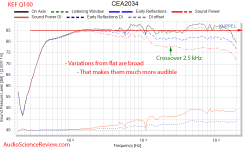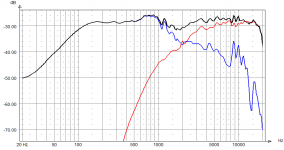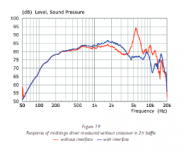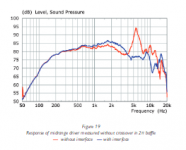I wonder because there is no dustcap, maybe it was difficult to damp this inner edge.The sound of the piano is slightly blurred because of the rubber that exists between the voice coil and the membrane. The voice coil and membrane must be firmly attached in order for even the smallest vibrations to be transferred to the diaphragm and converted into an acoustic signal.
I hope Dr. Jack Oclee-Brovn is aware of this problem.
KEF Q100 Speaker Review | Page 22 | Audio Science Review (ASR) Forum
[ Enclosure is made from MDF 19mm, front baffle 22 mm, internal bracing glued with elastic glue. Front baffle is glued to enclosure with soft polyurethane glue that is used for gluing car windshield. Driver is coupled with back and side walls... ]
Clarified, optimized... to see inside details

[ Enclosure is made from MDF 19mm, front baffle 22 mm, internal bracing glued with elastic glue. Front baffle is glued to enclosure with soft polyurethane glue that is used for gluing car windshield. Driver is coupled with back and side walls... ]
Clarified, optimized... to see inside details
Bass-reflex.Closed box, without rear bass-reflex?
Unfortunately I do not have any pictures of the later added supports.
The response certainly looks good with your crossover, but hard to judge who won the war without seeing the other side- what does the response look like on/off axis with the stock crossover?
KEF Q100 Speaker Review | Audio Science Review (ASR) Forum
In the above site you have measurements with a factory crossover. As there is one coil on the bass, the effect of membrane resonance at 10kHz can be clearly seen. That's why it sounds really bad.


And simulation of factory crossover

Last edited:
The other is a stupid thing is rubber ring they put in to control resonance membrane. I understand the engineering (since I am an aircraft engineer) approach to having a goal and now looking for a way to reach it, but you have to be aware that it is all a matter of compromise. Now, either they were aware that the sound would be compromised or they relied too heavily on measurements, and they didn't care much for the sound. Again on the other hand if they didn't do it I wouldn't be able to use the 6db / Oct switch with AL drivers.
I still enjoy these speakers, but I know it can do better, and that's what annoys me. The sound of the piano is slightly blurred because of the rubber that exists between the voice coil and the membrane. The voice coil and membrane must be firmly attached in order for even the smallest vibrations to be transferred to the diaphragm and converted into an acoustic signal.
I hope Dr. Jack Oclee-Brovn is aware of this problem.
This phenomenon is also present in the r series of drivers, and is also present in bass drivers.It measures ok or doesn't sound good. goes deep but sounds muffled.
Are you sure that there is compliance between voice coil and membrane?
At the moment I am working on something with the Q350 driver; the rubber ring is visible but seems to be a "glue holding" joint between voice coil and membrane; connection between these seems stiff though as far as I see/feel.
Daanve, More information you can find in link.
https://us.kef.com/pub/media/documents/rseries/rseries2018-white-paper.pdf
https://us.kef.com/pub/media/documents/rseries/rseries2018-white-paper.pdf
Last edited:
KEF Q100 Speaker Review | Page 21 | Audio Science Review (ASR) Forum
[ Some time ago Zvu passed me the files of his measurements and I did a few simulations based on his proposal for a new filter.
* It is important to me that the tweeter uses a first-rate filter and thus take advantage of the best quality of the components. With Miflex KPCU-01 0.022uF (22 nF in the image) 600Vdc as bypass cap.
* The other restriction was to keep the original woofer air coil. ]

With one or two filters at 1.4 kHz and 1.7 kHz ... with minimum phase PEQ + rePhase...
Proposed by Zvu

[ Some time ago Zvu passed me the files of his measurements and I did a few simulations based on his proposal for a new filter.
* It is important to me that the tweeter uses a first-rate filter and thus take advantage of the best quality of the components. With Miflex KPCU-01 0.022uF (22 nF in the image) 600Vdc as bypass cap.
* The other restriction was to keep the original woofer air coil. ]
With one or two filters at 1.4 kHz and 1.7 kHz ... with minimum phase PEQ + rePhase...
Proposed by Zvu
My proposition should be looked at for what it is - quick and cheap way to remove the midbass resonance from the sound of finished loudspeaker using the most out of factory crossover components.
If i were to build the crossover to correct all the things bugging me with Q100, it would probably look a lot like what Jokerbre did.
If i were to build the crossover to correct all the things bugging me with Q100, it would probably look a lot like what Jokerbre did.
Last edited:
In my opinion, this speaker sounds better than the LS50.
But...
As with the LS50 as well as the r300 also with this speaker, I have problems with two things. The first is the ferrofluid in the tweeter. The tweeter sound is great but it can be better. I have repeatedly found that removing ferrofluids from the tweeter has a very beneficial effect on sound, which is logical. But because of the bad crossover it was necessary to protect them somehow.
The other is a stupid thing is rubber ring they put in to control resonance membrane. I understand the engineering (since I am an aircraft engineer) approach to having a goal and now looking for a way to reach it, but you have to be aware that it is all a matter of compromise. Now, either they were aware that the sound would be compromised or they relied too heavily on measurements, and they didn't care much for the sound. Again on the other hand if they didn't do it I wouldn't be able to use the 6db / Oct switch with AL drivers.
I still enjoy these speakers, but I know it can do better, and that's what annoys me. The sound of the piano is slightly blurred because of the rubber that exists between the voice coil and the membrane. The voice coil and membrane must be firmly attached in order for even the smallest vibrations to be transferred to the diaphragm and converted into an acoustic signal.
I hope Dr. Jack Oclee-Brovn is aware of this problem.
This phenomenon is also present in the r series of drivers, and is also present in bass drivers.It measures ok or doesn't sound good. goes deep but sounds muffled.
My experience with Kef UniQ loudspeakers is limited to LS50, which I owned a short while, and the now running series Q350.
Always combined with active subwoofers as, IMO, small speakers are not able to reproduce large scale music (orchestral) faithfully; so the Kefs were not active below 100 Hz or so.
What struck me from the beginning is that these coaxials excel in painting a fine acoustic space; in whatever review this comes out as one of the highlights.
Personally, though I am not aircraft engineer but just a guy who has been active in professional and consumer audio for almost half a century now (doing quite some recording of live music), and, besides, an active amateur musician, I have no trouble with the quality of piano reproduction at all. On the contrary, I find it done very well with these speakers. Chamber music also is done very well.
Your theory about the rubber ring between voice coil and cone is hypothetical at least; not before you manage to bridge the compliance with something "stiff" and do some critical listening afterwards (with all the possible traps of A/B comparisons and confirmation bias), you "might" conclude.
The picture below (thanks for pointing me to the Kef paper) illustrates what the rubber ring "does". It completely removes the peak around 5 kHz, allowing simpler crossovers.
I must say that the sound quality of my Q350, with only an inductor, capacitor and resistor as crossover components, is already remarkable, but I agree that it can possibly be improved.
IMO, you will have a very difficult job to get there with a stiff mechanical joint between voice coil and cone and a much more complex crossover, but I curiously will wait with what you will come up.
Attachments
It is not a matter of preference but of physics, the task of the speaker is to convert the electrical signal into an acoustic one. There must be a firm bond between voicecoil and the membrane. Look at it this way, the car is a membrane, the road is voicecoil, if you have a tire and you have it, you will feel the road but far softer.
It is not a matter of preference but of physics, the task of the speaker is to convert the electrical signal into an acoustic one. There must be a firm bond between voicecoil and the membrane.
Kef made the connection compliant to give it a low pass function and allowing less complex crossovers. Very clever engineering.
That the bond should be firm is just your opinion and reflects your thinking which is perfectly OK, but has nothing to do with loudspeaker physics.
Look at it this way, the car is a membrane, the road is voicecoil, if you have a tire and you have it, you will feel the road but far softer.
With reason yes, unless you want your teeth rattling.
You are an aircraft engineer?
What will happen if a wing is stiff, not being able to bend?
Yes...plane will crash
Kef made the connection compliant to give it a low pass function and allowing less complex crossovers. Very clever engineering.
That the bond should be firm is just your opinion and reflects your thinking which is perfectly OK, but has nothing to do with loudspeaker physics.
With reason yes, unless you want your teeth rattling.
You are an aircraft engineer?
What will happen if a wing is stiff, not being able to bend?
Yes...plane will crash
In trying to insult me, you hit the point. Yes, I do not want to convert these vibrations into thermal energy, but I want to transfer them to the membrane.
Well, it is not my intention to insult you; I trust that you know a lot about aerodynamics.
That however does not imply that you know as much about loudspeaker physics and acoustics.
Shall we agree upon the fact that we disagree here, and that you are welcome to back up your blanket statements by proven and measured facts?
That however does not imply that you know as much about loudspeaker physics and acoustics.
Shall we agree upon the fact that we disagree here, and that you are welcome to back up your blanket statements by proven and measured facts?
Well, it is not my intention to insult you; I trust that you know a lot about aerodynamics.
That however does not imply that you know as much about loudspeaker physics and acoustics.
Shall we agree upon the fact that we disagree here, and that you are welcome to back up your blanket statements by proven and measured facts?
Upon fact? Hardly that is a fact, more than your assumption.

Look how FR response is different. and i will give you a hint, Q-resonance.
- Home
- Loudspeakers
- Multi-Way
- Justice for KEF Q100

